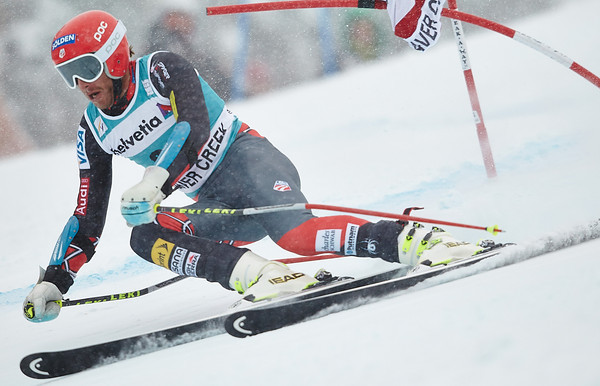All successful sports teams need stars. Quick. Name the quarterback of the Denver Broncos. Easy. He's the guy who did a hilarious interview a few days ago with that Ron Burgundy fellow. Now -- who's the quarterback of the Tampa Bay Buccaneers? Right.
The U.S. Ski Team's alpine racers get noticed most -- particularly when it's almost Olympic time -- when the likes of Ted Ligety, Bode Miller, Lindsey Vonn and Mikaela Shiffrin are rocking it. Except for Shiffrin, the teenage slalom sensation who is newly showing promise across the board, the season had started slowly. Until Sunday.
Ligety and Miller went 1-2 in the giant slalom at the men's World Cup stop at Beaver Creek, Colo., while Vonn, who had gone a cautious 40th and then 11th in the downhills Friday and Saturday in making her return to the women's tour in Lake Louise, Canada, rocketed to fifth in Sunday's super-G and afterward declared she was "ready for Sochi."
Shiffrin didn't race this weekend. She did, however, sum up the excitement that seized the scene.
"I'm crying right now," she tweeted out. "My favorite racer is back on the podium. #gobode"
This was Miller's first top-three finish since February 2011 (a second in the downhill in Chamonix, France). It marked his first giant-slalom top-three since March 2007 (at the World Cup finals in Lenzerheide, Switzerland).
The last time two Americans were on the GS podium together? Bode and Daron Rahlves, at the 2005 GS in Beaver Creek.
Ligety, meanwhile, is without question best in the world in the giant slalom. And he emerged last year, with three gold medals at the world championships, as the rock of the U.S. team.
Sunday's victory marked Ligety's fourth straight World Cup victory in the GS; that ties him with Italian great Alberto Tomba, who won four straight in 2001.
Ligety is so good at this particular event that he has finished on the podium in his last 10 GS races. That is the second-longest streak of GS podiums in World Cup history. With it Ligety joins Tomba, Ingemar Stenmark of Sweden and American Phil Mahre.
This was, moreover, Ligety's third GS win in a row on the Birds of Prey course at Beaver Creek.
Ligety's winning combined time Sunday: 2:35.77. He won both runs, and easily.
The surprise -- unless you were keenly paying attention to Miller earlier in the week -- was that Bode took second. He finished 1.32 seconds behind Ligety. Austria's Marcel Hirscher took third, 1.82 back.
It's not that Miller isn't capable. He is the most successful alpine racer the United States has ever produced, among other things a five-time Olympic medalist as well as the 2005 and 2008 World Cup overall champion.
But after taking last year off to mend a bum knee, you would have to have been a true student of racing, and of Bode, to see this coming.
In Friday's downhill at Beaver Creek, Miller finished 13th. In Saturday's super-G, he held a huge lead of more than a second on the top part of the course before nearly missing a blind gate after a jump; he then -- typical Bode -- made an amazing recovery to finish 14th.
After Friday's race, he said, "I skied the way I need to. Maybe we picked the wrong skis. Maybe it was just weather or nature."
After Saturday, he said, "Yesterday and today I hit the thing really well, so I think that's really encouraging."
Bode is -- finally -- back in shape, as he emphasized after Sunday's finish.
So anyone who has been listening carefully to him for years can easily explain what he was, in his way, telling everyone over the weekend:
The thrill show is back on. He is now a legitimate threat to win any and every race he's in.
Ladies and gentlemen, that is good for ski racing. Bode is not just the best the United States has ever thrown out there, he is the most interesting because every race is an exploration of what it's like to throw yourself out there without fear.
He's on new skis in every one of his events, he cautioned. Even so, the knee feels good.
"I"m ready," he said. "I'm skiing well in every event. It hasn't come out in the races yet. But it will."
The U.S. Ski Team is loaded with talent. Six American women, for instance, finished in a World Cup top-three last last season in the downhill or super-G. And, of course, beyond Miller, Ligety, Vonn and Shiffrin, there is Julia Mancuso, a big-game racer if there ever was one.
That said -- to have Bode Miller back injects a different dynamic. To pretend otherwise is just silly. Everyone knows it.
He took second Sunday, for instance, after starting the first run as the 31st skier down the hill. That is very hard to do.
Whether Miller -- who knows only one way, to ski all-out -- can over the next weeks and months be consistent is the thing. "Sharing the podium with Bode is awesome. I'm a little surprised, actually," Ligety noted. "He probably doesn't like it when I say that, but it was impressive how he was able to bring his intensity up and put down some impressive runs."
"It's a little bit of redemption today," Miller said. "It shows that I'm coming back in GS. I think I can do it in slalom, too," adding a moment later, "The idea is to be able to ski four events the way I like to do it."
He also said, "There's little tiny pieces that are missing. It's just timing … just little parts that have to come back," adding after, "I feel like I'm ready."





